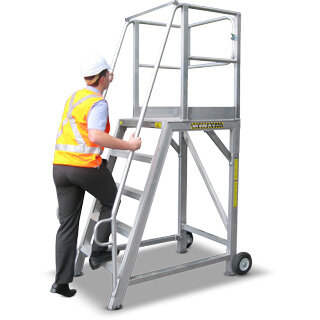Should We Get Rid of Ladders?
Ladders are Dangerous
Thousands of people fall from ladders every year, including at home and at work. Unfortunately, many of those who fall sustain fatal or serious injuries.
Unsafe use of ladder
Legal Requirements
The workplace safety regulations in each jurisdiction clearly specify the requirements for working safely at height.
Preferred Options for Work at Height
The hierarchy of control (eg Vic OHS Reg 44 and WHS Reg 78) for working at height requires us to:
1st Do the task from ground level if possible eg use extendable pole to wash windows or change screw-in lights; or if not reasonably practicable;
2nd Complete task from a solid construction eg scaffolding; or
3rd Use a passive fall prevention system eg harness with short tether so worker cannot reach the edge and fall; or
4th Use a work positioning system eg scissor lift or boom elevator; or
5th Use safety harness fall arrest system; and if all the above are not reasonably practical then you may;
6th Use a fixed or portable ladder (incl. >2m high), with safety precautions.
Therefore, use of tall portable or fixed ladders is not in breach of workplace safety legislation, but they are the least preferred method.
As a result of recognizing the risks, many best practice organisations have started to remove ladders from work areas.
Ladders are Not Work Platforms
Traditionally people worked from ladders, but today they should only be treated as a means to access a work area.
Workers cannot work from ladders if the task requires two hands as we must always have 3 points of contact when on a ladder eg two hands and one foot or two feet and one hand.
Ladder/Stair system with safer platform to work from
Examples of attachments to help make ladders safer to use
Instead of banning ladders we should focus on replacing traditional ladders with safer and more efficient systems where possible.
For more information on this topic or a copy of our Fact Sheet on Causes of Ladder Accidents & How to Prevent Them call us on 03 8544 4300 or email us.
Click here for our associated blog “Can We Use a Domestic Ladder at work?”



